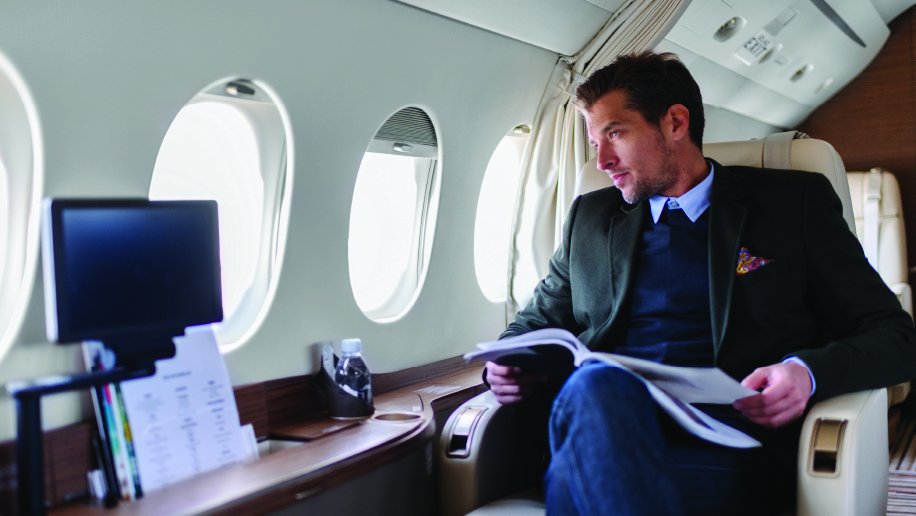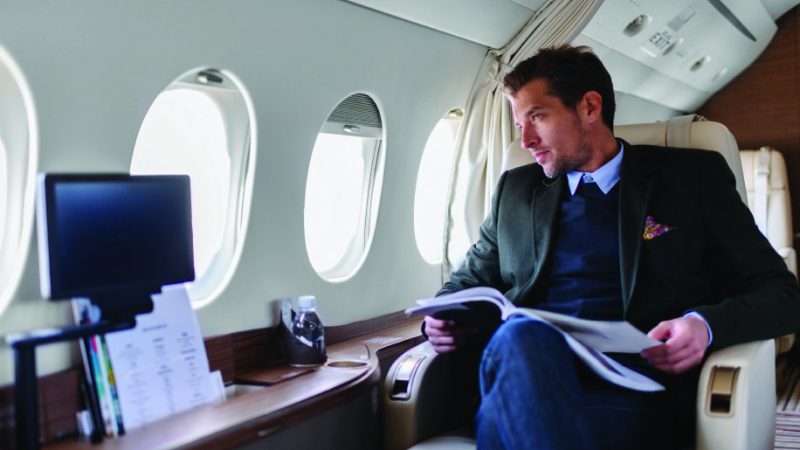High Value Proposition
Flexible, responsive and surprisingly affordable, business aviation makes a compelling case for companies of all sizes
July 1, 2020


In March and April, when 90 percent of the world’s commercial airliners were grounded, practically the only flights still taking off for business travelers were aboard private aviation aircraft. Granted, global coronavirus-related travel restrictions caused business jet operations to plunge 75 percent year over year, but by contrast commercial aviation came to a near-total standstill.
Which underscores one of private aviation’s strong suits: Flexibility.
Actually, private jets have been increasing their domain for some time, attracting a new kind of business traveler. While mega-corporations have their own fleets, it’s the mid-echelon businesses and their employees who are increasingly benefitting from access to this alternative to flying commercial.
The reasons are legion, but in the midst of the COVID-19 crisis, other key drivers that have surfaced are safety and availability. Add to these the well-known advantages of efficiency and ease of travel, and it’s little wonder private business aviation is increasingly seen as a go-to solution for business travelers.
Out of Harm’s Way
The novel coronavirus pandemic is arguably the most serious existential threat ever to face the global travel industry. As Marriott’s CEO Arne Sorenson said during the company’s first quarter earnings call, “This is by far the most significant crisis ever to impact our business. For a company that is 92 years old and has weathered the Great Depression, World War II and numerous natural disasters around the world, that is saying something.”
However serious it may be, COVID-19 is not the first crisis to confront the industry. A steady diet of global headlines reporting hurricanes, earthquakes, political unrest and terrorist attacks emphasize the importance of preplanning to ensure employees are taken out of harm’s way during emergencies.
“Travelers face language, resource and cultural challenges during emergencies and you want to relieve them of that as soon as possible,” says Dr. Robert Quigley, International SOS senior vice president and regional medical director of the Americas. “Our job is to work with companies and create a partnership for the care of their employees.”
International SOS is a global service provider that evaluates and manages risks and evacuations. As the pandemic crisis intensified, ISOS provided air ambulance transportation for confirmed COVID-19 patients, as well as chartering evacuation flights globally, including from China. However, as the company states on its website, making these flights happen is dependent on a number outside factors – including authorizations from governments, health agencies and aviation authorities.
“Therefore there may be a significant lead-time to confirm the feasibility of such evacuations as these variables are beyond the control of International SOS,” the website advises. The warning underscores the need for advanced planning to respond to the unexpected. It takes time but costs nothing to ensure vendors are vetted and approved – including establishing relationships with private aviation providers if those services fit your company’s overall travel strategy.
“Emergencies are an afterthought for most people,” notes Dr. Brendan Anzalone, CEO and chief medical officer of AeroMD. “Most people don’t know where to start or who to call or whether they are any good. That’s why the key to success is preplanning.”
Who Do You Trust?
When the pandemic turns the corner and business stages a comeback, how will this global experience have permanently altered the travel landscape? “As the COVID-19 crisis spread, we had a lot of healthy members anxious to get home,” says Michael Hallman, CEO of Medjet in Birmingham, AL. “When business travel does resume, I think there will be a much higher focus on health and safety solutions for travelers. End-to-end, door-to-door travel planning, vetting ‘safe’ destinations, ‘clean’ hotels, ‘trusted’ restaurants, ‘known’ cars and drivers, and elevated health event solutions.”
Knowing who to trust for air travel services is one key reason companies are turning to private aviation. But in very conservative, down-to-earth corporate cultures, private jets are viewed as an expensive luxury reserved only for the largest corporations. “We’re just not big enough to fly private” is often the lament heard from some of these companies.
That’s one common misconception about business aviation that’s been shaken to the core by coronavirus. In fact, the vast majority of business aviation flights are for small- and medium-sized businesses; nearly 60 percent of all companies using business aviation have fewer than 500 employees and only one aircraft.
Business aviation is not just for CEOs and sales people. Users include middle-management customer service and technical representatives responding to client needs.
Companies are also turning to business aviation after realizing business aviation users are far more successful than their non-user counterparts. One study of small and medium-sized companies on the S&P 500, entitled Business Aviation: An Enterprise Value Perspective, concluded companies that use business aviation services:
•Drove higher revenues, greater profitability and improved efficiency
•Were overwhelmingly represented among the most innovative, most admired, best brands and best places to work
•Were able to tap more business opportunities yielding 22 percent higher average revenue growth
Perhaps most telling, as countries start to emerge from the cloud of the global COVID-19 economic slowdown, the study found those companies that harness business aviation weathered recessions better and recovered quicker.
The calculus is really more about the value of time versus the cost of ownership, and when the availability of travel alternatives dries up completely as it did this spring, the time/cost equation takes on a radically different look. Business aircraft become another tool – and perhaps the only tool – to help the company accomplish its objectives and create efficiencies.
Private aviation travelers can get to the airport as little as 15 minutes before flight time, compared to the 90-plus minutes required of commercial passengers, avoiding crowds at ticket counters and TSA. Once passengers are on board, the flight can often take off immediately and travelers can get down to business in safety and privacy, without worrying who’s sitting in the seat beside them. And when teams travel, it’s possible to move them together at a price point close to – or in some cases less than – to cost of commercial flights.
Choosing The Right Option
The most common questions prospective private jet business travelers ask revolve around the myriad options to access the product. The good news is, there’s a process to determine if your company’s travel patterns could be optimized by using private aviation.
After determining whether private jets actually have a place in your company’s travel strategy, the next question is what precisely is best way to make that happen. That requires evaluating the return on investment in business aviation, encompassing:
•current travel costs
•the projected costs of business aviation
•projected ROI
•the projected savings of private jets.
Once the value of including business aviation in the company’s strategic plan has been determined, it’s time to determine the best fit of aircraft type and mode of purchase based on typical travel passengers, passenger group size and amenities. However ‘mode of purchase’ does not necessarily mean ‘buying an airplane.’ In the multi-faceted world of private jet travel, what that really entails is [ital] access [end ital] to the aircraft.
Full aircraft ownership is generally reserved for those flying more than 350 to 450 hours each year, so is probably not the first option for companies just testing the waters. Instead there are fundamentally three options for companies seeking more selective – and less costly – access to private aviation: fractional ownership, jet cards and on-demand charter.
Fractional ownership lets companies own a share in a private jet, while at the same time limiting direct responsibility for the aircraft as well as the required oversight. There are a number of fractional providers, NetJets, FlexJet and Executive AirShare among them. This avenue is best suited for business travelers who take wing at least 100 hours per year. Fractional commitments last a full five years, and typically involve a commitment of at least 50 flying hours per year.
Upside:
•Fractional private jets are modern and of quality manufacture
•Service standards are high
•There are no ‘deadheading’ or repositioning costs involved
•There are possible tax advantages linked to depreciating your share of the private jet.
Downside:
•There are decidedly high barriers to canceling or leaving the fractional agreement
•Capital costs can be significant
•Flexibility can be a problem. Flying on peak period days can require several days advance notice. Fractional owners have to be flexible in their schedules.
•Fuel surcharges can be a pain. They vary a lot and are significantly higher than those of on-demand charter operators.
Jet cards offer an alternative to the sort of multi-year contracts offered by fractional ownership by aggregating demand. That means they can aggregate lift and offer “a guaranteed fixed rate.”
These jet cards work best for business travelers who fly just a few times per year up to 300 hours or so.
Upside:
•Guaranteed availability
•Relatively low upfront commitment
•Guaranteed fixed pricing
•Strong ability to recover from mechanical issues
•Relatively short term agreements
•Compared to fractional ownership, user terms are more flexible.
Downside:
•Some jet card programs are non-refundable and non-cancelable
•Some routes flown by jet card aircraft are simply not cost competitive
•A number of peak period days require several days advance notice.
On-demand charter There are some 2,200 aircraft charter operators in the United States alone. They can vary significantly when it comes to both safety and quality
Insurance, pilot experience and aircraft age vary widely, so charter operators must be vetted thoroughly prior to signing each agreement. Here are a few advantages and disadvantages of using charter business aircraft.
Upside:
•No upfront commitment. Pay just for what you need
•Lower hourly rates
•You can select the crew.
Downside:
•Severe trip cancellation policies
•Market fluctuations mean pricing for the same trip can vary widely, depending on even the day of the week
•Depending on the on-demand charter operator, services can vary significantly.
The coronavirus pandemic is only one of myriad factors that are forcing many companies to rethink their travel strategy. They are asking more questions to understand why they are traveling, what benefit travel brings, and whether there’s more than one way to get from Point A to Point B.
Until someone invents a Star Trek-like transporter there’s no magic bullet solution except get smarter about how travel gets done. In this environment, business aviation – whether by twin-engine turboprops or intercontinental jets – deserves a closer look. Business aviation is definitely not just for the rich – but it is for the successful.




